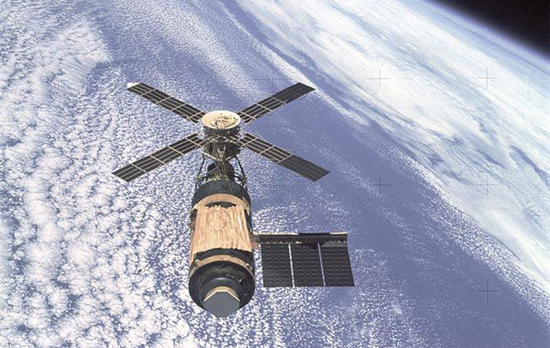
Lifehacks, or easy and efficient ways to make life a little simpler, have become a commonplace topic on the Internet. From cooking to interior design, lifehack suggestions are everywhere. However, it turns out that those of us who are earthbound aren't the only ones who know the value of repurposing items or finding new ways to accomplish tasks. Over the years, astronauts have used lifehacks to fix critical equipment, to overcome odds and even to save their lives.
1. Houston, we have a lifehack
Photo: NASA
The Apollo 13 mission is the most famous example of astronauts, with help from ground control, hacking their way out of a near-fatal situation. After the explosion of an oxygen tank damaged their spacecraft, Apollo astronauts James Lovell, John Swigert and Fred Haise had to figure out how to survive and how to return to Earth safely. Chief among their problems was a dangerous rise in the level of carbon dioxide. Mission control aided the astronauts in "hacking" the situation to create a solution: an air scrubber. The air scrubber would allow the astronauts to use air canisters from the command module (CM) to clean the air in their improvised "lifeboat," the lunar module (LM). According to NASA, "Mission control devised a way to attach the CM canisters to the LM system by using plastic bags, cardboard and to tape all materials carried on board." Mission control further aided the astronauts by instructing them on how to survive their return to Earth. This wasn't just a lifehack in space, but a life-saver.
2. Hubble in trouble
In 1990, shortly after its launch, the Hubble Space Telescope encountered critical problems with one of its mirrors. The solution for fixing the blinded telescope came from, of all places, the bathroom. Optical engineer James Crocker was taking a shower in Germany where serendipity struck. According to MIT, "On a break in his hotel room, [Crocker] was adjusting the showerhead - a European design that extends or retracts to accommodate one's height - when an idea came to him: Why not outfit Hubble with corrected mirrors built on robotic arms that can extend into the telescope and retract into place, just like an adjustable showerhead?" This notion eventually became the Wide Field and Planetary Camera 2, which would replace the broken mirror. In 1993 astronauts journeyed to the Hubble and replaced the mirror with the WFPC2, allowing the telescope to see again.
3. The ISS's [tooth]brush with disaster
In 2012, the International Space Station encountered issues with a Main Bus Switching Unit, which, according to The Atlantic, "harnesses and then distributes power from the outpost's solar arrays." In order to repair the malfunction, astronauts Sunita Williams and Akihiko Hoshide went on a spacewalk and discovered that matters were even more complicated. They saw that metal shavings had gathered around one of the MBSU's bolts, which prevented Williams and Hoshide from removing it. They returned inside the ISS and figured out what tools they would need to fix the problem - one of these tools, in particular, was crafted from an ordinary toothbrush. Sure enough, the astronauts were able to dislodge the debris with their toothbrush hack, and the ISS lives to orbit today.
4. An off-the-cuff fix
In 2007, blanket panels on the ISS's solar arrays developed tears. Engineers came up with a solution. They would create custom "cuff links" using materials on board. The cuff links were able to interface with the blankets and the wiring on the solar arrays, successfully pulling the blankets into proper position.
5. A not so pie-in-the-Skylab solution
Before the ISS, there was Skylab. When Skylab was first sent to orbit into 1973, it immediately encountered problems. The lab's micrometeoroid shield failed, on-board temperatures were too high and power production was compromised. Hackaday.com describes the near catastrophic event, "While it was tearing free, the [micrometeoroid] shield ripped one of the two solar arrays mounted on the side of the workshop clean off, while simultaneously jamming the remaining array with debris that prevented it from deploying fully." Engineers came up with a solution; they would need: "a Mylar parasol with a collapsible shock-tube frame that would be deployed through the small airlock." According to Hackaday.com, Marshall Spaceflight Centre engineers went to a hardware store and gathered materials to make the necessary equipment. They acquired additional parts from a supplier to a power company. The astronauts who were sent to perform the repairs, Pete Conrad, Joseph Kerwin and Paul Weitz then used the custom apparatus to fix the space station. This saved NASA from losing Skylab's US$2.2 billion investment.
It turns out these scientists astronauts have more than just the right stuff. They have creativity in the face of danger and engineering know-how that would make MacGyver proud.
Related on Mother Nature Network:
Top image: Toothpaste and toothbrush floating on the flight deck of Discovery, STS-70. A toothbrush once saved the International Space Station. Credit: NASA/Wikimedia Commons.





No comments:
Post a Comment
Please adhere to proper blog etiquette when posting your comments. This blog owner will exercise his absolution discretion in allowing or rejecting any comments that are deemed seditious, defamatory, libelous, racist, vulgar, insulting, and other remarks that exhibit similar characteristics. If you insist on using anonymous comments, please write your name or other IDs at the end of your message.